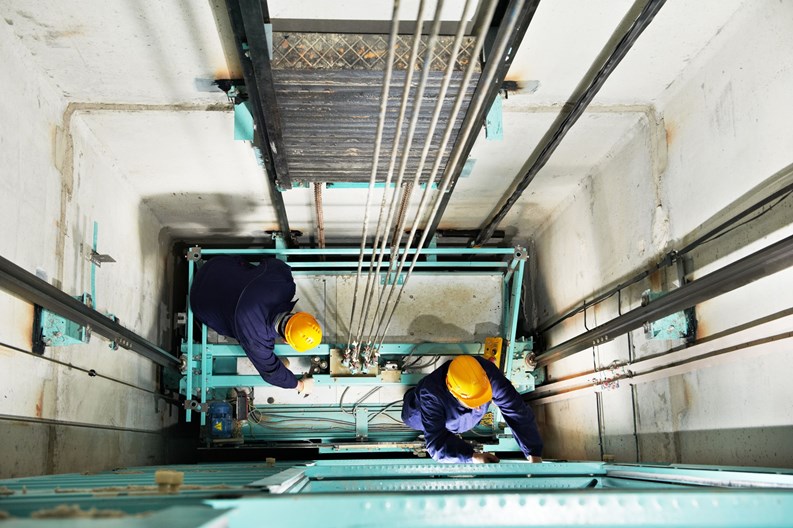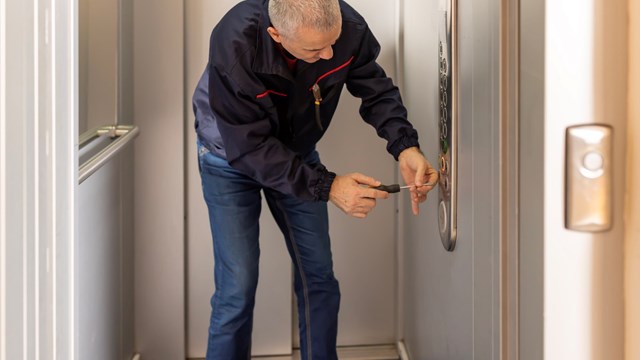No matter how well-constructed and carefully maintained, no mechanical system lasts forever – and that goes for elevator cabs and equipment just as much as it applies to roofs or boilers. At some point, your building’s vertical transportation comes to the end of its useful life, and the inconvenience of refurbishment and replacement becomes a reality for residents. If you live on a lower floor – say the first, second, or even the third story – the inconvenience may not be too severe. If you live in a building with multiple elevators, it’s unlikely that more than one will be taken out of service for upgrading at a time. But if you live in a building with a single elevator and reside above the first few floors, or if you have trouble climbing stairs at all, let alone carrying packages up or down, an elevator upgrade can become a real nightmare.
“Single elevator buildings are a challenge,” says Joe Caracoppa, an elevator consultant with Sierra Consulting Group, a New York City-based elevator consulting firm. “The question is how do you get the people up and down for six to eight weeks while the work is being done and completed? [The answer] is usually walking up and down. When the elevator is out, it’s out. It can’t be used temporarily.” On the other hand, Caracoppa continues, “Multi-elevator buildings are easy. You always have another car, a freight car or the other passenger elevator. But if it’s just a single elevator, well, no one can use the elevator during the process, and it must be tested by the city before it can be put back into operation.”
Planning for the Inevitable
Jacqueline Duggin is a building manager with Gumley-Haft, a Manhattan-based residential property management firm. She manages a seven-story, single-elevator building on Manhattan’s East Side that recently underwent a total refurbishment. The property was built at the turn of the twentieth century, and so is over 100 years old. The single elevator required modernization and refurbishing. “The board really had to think a lot about the project, and about this problem,” Duggin says. “We had people in the building, one family in particular, where someone was disabled and used a wheelchair. There was no way this resident could go up and down the stairs. Another resident had two very large dogs, and they couldn’t go up and down numerous times a day, either. There was no way we could accommodate them. In the end, the board did arrange to do the work during the summer months when many people were away on vacation. The resident with the dogs had a summer home and went there for the duration of the project. The disabled resident stayed with a family member elsewhere. For other residents who were able to go up and down the stairs, we accommodated them by hiring extra staff to help people with their groceries, luggage, etc. We placed chairs on each landing and provided cold bottles of water for anyone who was tired or overheated.”
Another example of community outreach during an elevator upgrade played out at a close-knit, mid-size co-op in Upper Manhattan’s Hudson Heights neighborhood. Built in 1939, the 56-unit building has only one elevator. The cab and equipment were completely refurbished a few years back, presenting the co-op community with a very unique set of challenges. The building was home to about half a dozen residents who were past 90 years of age – all living above the fourth floor. Hope Kaye has been a resident of the co-op for 15 years, and says that most of the elders were former refugees from Eastern Europe during World War II, and as such were perhaps less likely to ask for help than others might be. According to Kaye, those who had children didn’t have them living close by. In order to support and assist their neighbors, the community became proactive.
“One unique aspect of the problem was that these six elderly shareholders took their lunch every day at a senior center around the corner at a synagogue social program,” Kaye explains. “Their social lives required them to leave the building daily. So we set up a protocol to help them without asking them if they needed help. We placed folding chairs on each landing to provide a ‘rest stop’ after each flight of stairs. We also organized a program to check in on them, and offered to do their errands – things like food shopping, picking up dry cleaning, etc., that they might not be comfortable asking a neighbor to do. For those who wanted to do their own shopping, we had the super and residents who were home during the day on lookout to help them carry their bags up the stairs. We did a similar thing with garbage disposal. All garbage must be sorted for recycling, and so had to be carried down to the first-floor collection area, because building’s garbage chute was sealed up years ago. We made sure that when we took down our garbage, we took down theirs, too.”
Kaye says the elevator project took approximately six weeks. “If anything,” she says, “the project, and the way we handled it brought us closer as a community.”
Another important consideration when it comes to navigating a major elevator project is to enforce the time frame and schedule set out by the elevator contractor in their refurbishment or replacement contract. According to Duggan, “The contract the building signs with the company doing the work will contain a clause specifying a timeline and completion date. If that timeline and date are not met, the contract will contain penalties.” While delays in any type of construction work are typical, when it comes to something as crucial to the community as elevator work, both the board of directors and management need to stay on top of the situation to minimize the inevitable disruption.
The Legal Angle
What are the real liabilities a co-op or condo board should consider before proceeding with an elevator project? Howard S. Goldman, an attorney and principal with Needham, Massachusetts-based law firm Goldman & Pease, explains:
“As set forth in the Declaration of Trust establishing the condominium, the trustees of an association have a duty to maintain the common areas of the condominium. Thus, when the sole elevator servicing a seven-story building is out of service, the trustees have a duty to repair it in a timely manner. With respect to whether the trustees may be liable to unit owners who depend on the elevator for access to their units, the answer is complicated and depends on the facts and circumstances of the case.”
Laws, rules and regulations affecting this contingency exist at all levels. According to Goldman, “The Federal Fair Housing Act (42 USC sec. 3604) and state anti-discrimination statute (M.G.L. c. 151B) – [known] collectively as ‘Fair Housing Laws’ – are applicable to condominiums, and expressly prohibit disability-based discrimination. Pursuant to these, trustees could be liable to unit owners for failure to accommodate a request for reasonable accommodation during the time an elevator is out of service. The unit owner would bear the burden of establishing that they have a physical or mental impairment which substantially limits one or more major life activities, that they made a request for an accommodation related to that disability, and that the request was reasonable and necessary to afford them the equal opportunity to use and enjoy their dwelling.”
All that being said, there is no bright-line test to determine whether a requested accommodation is ‘reasonable.’ “Instead,” Goldman continues, “courts interpreting Fair Housing Law violations make fact-specific determinations of whether a request is reasonable given any undue hardship the condominium association might incur in order to comply with the request.” He explains further that the criteria for determining whether an accommodation request crosses over into undue hardship territory include the nature and cost of the accommodation, the overall size of the property – including the number and type of units – and the size of the condominium’s budget and available reserves.
“If a disabled unit owner requests that their trustees provide alternative housing...for the duration of the repair work, the trustees would have a duty to work with that unit owner to accommodate the request, provided that the request did not impose an undue hardship on the condominium association,” Goldman continues. “But, of course, paying to relocate an aggrieved unit owner would be very costly – and for that reason would most likely not be required. The trustees do not have an affirmative duty to provide alternative housing, unlike [the] duty imposed upon a landlord renting his or her unit via the Warranty of Habitability. That only applies in a landlord/tenant relationship. A condominium should consider obtaining what’s known as an equipment breakdown rider to its insurance. It provides coverage for the repair costs, but [trustees] should also inquire if dollars are available for temporarily relocating unit owners and/or tenants. In the end, however, given the fact-specific nature of Fair Housing Law violations, the trustees should err on the side of caution and always consult an attorney to determine the best course of action to avoid liability.”
When it comes to something as crucial – and as potentially disruptive – as a major elevator repair/replacement project, co-op and condominium boards should be proactive and communicative, and should reach out to all the occupants and determine who, if anyone, will need accommodations and how those can be reasonably made. Open a dialogue with all, and do not ignore the issue until it is too late. It’s always better to be communicative and proactive, rather than tight-lipped and reactive. The worst thing that can be done is ignoring the issue until it is too late. Each board should understand and expect that there may be requests for accommodations and should, at all times before, during and after the bid process and during the pendency of the work, be ready to assist and respond to reasonable requests.
A J Sidransky is a staff writer/reporter with New England Condominium, and a published novelist.










Leave a Comment